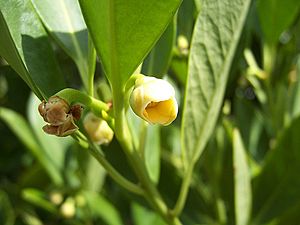Yellow anisetree facts for kids
Quick facts for kids Yellow anisetree |
|
|---|---|
 |
|
| Conservation status | |
| Scientific classification | |
| Genus: |
Illicium
|
| Species: |
parviflorum
|
 |
|
| Natural range | |
Illicium parviflorum, also known as yellow anisetree or swamp star-anise, is a beautiful flowering plant. It's a type of shrub or small tree that smells a bit like licorice! This plant is native to Florida in the United States. It used to grow in Georgia too, but it's not found there naturally anymore.
Contents
What Does Yellow Anisetree Look Like?
The yellow anisetree is an evergreen plant, meaning it keeps its leaves all year round. It can grow as a shrub or a small tree, sometimes reaching up to 7 meters (about 23 feet) tall. It often has several main stems.
The wood, leaves, and flowers all have a nice smell, similar to licorice. Its leaves are tough and oval-shaped, growing up to 15 centimeters (about 6 inches) long. They are shiny dark green on top and lighter underneath.
The flowers are small, about one centimeter (less than half an inch) wide. They have 11 to 14 yellow-green petals, called tepals, and many small parts for making seeds. After the flowers, the plant grows a unique star-shaped fruit. This fruit is made of up to 13 small pods, and each pod holds one shiny brown seed. When the pods open, they release the seeds. This plant can survive cold weather in many parts of the US.
Where Does Yellow Anisetree Grow?
This plant likes to grow in wet places. You can find it in moist soils, like those in floodplains (areas that get flooded) and hammocks (small islands of trees). It also grows near swamps and along rivers or streams.
Other plants that often grow near the yellow anisetree include the Atlantic white cypress, Florida hobblebush, and different types of palmetto trees like common palmetto and bush palmetto. You might also see it with needle palm, sweetbay, and swampbay.
Is Yellow Anisetree in Danger?
The yellow anisetree is not very common. It is currently found in fewer than 20 places in Central Florida. These areas are mainly in Polk, Marion, Lake, Volusia, and Seminole Counties.
The biggest threat to this plant is losing its natural home. Changes in how water flows in its habitat are also a problem. Sometimes, people also collect the plants from the wild to grow them in their gardens.
How Do People Use Yellow Anisetree?
People often grow the yellow anisetree because it smells nice and looks attractive. It's used as an ornamental plant in gardens. It can be trimmed and shaped to create thick hedges or windbreaks, which help block wind.
This plant can grow very densely because its roots send up new shoots. Its branches can even grow roots if they touch the soil. It's known to be easy to grow and doesn't usually have many pest problems. If not trimmed, it can spread out up to 4.5 meters (about 15 feet) wide. If you remove the lower branches, you can shape it into a small tree. It's also easy to buy and not very expensive.
Important Safety Note: This plant is poisonous! You cannot use it as a spice, unlike its relative, star anise, which is used in cooking. Make sure you know the difference!


